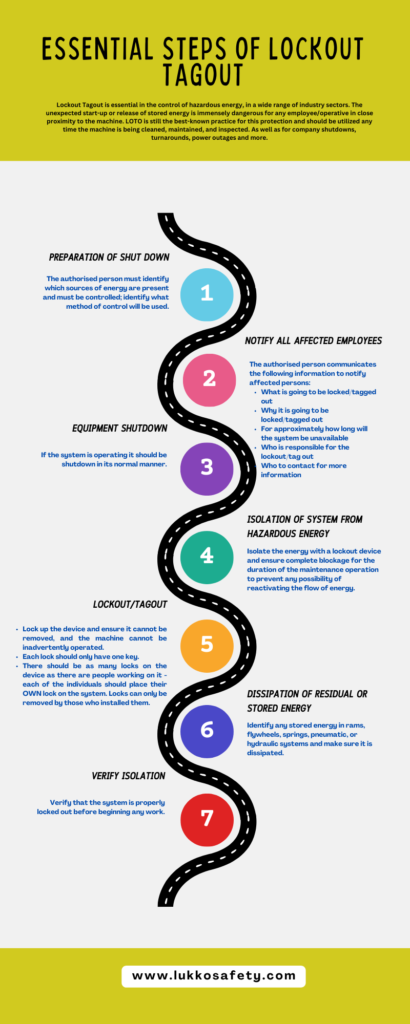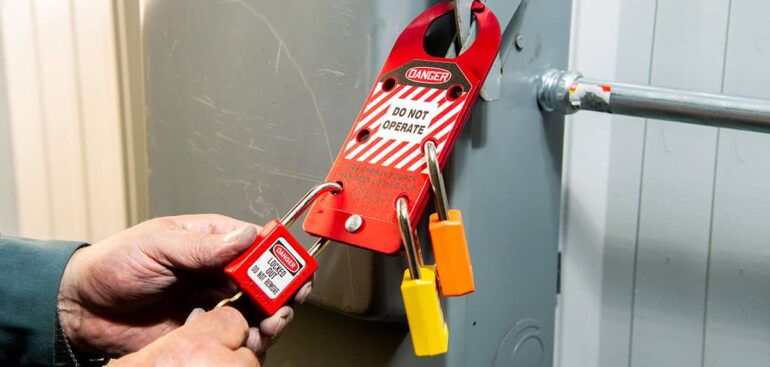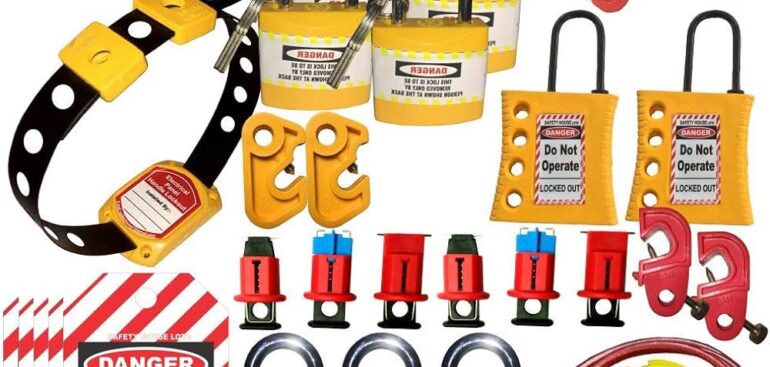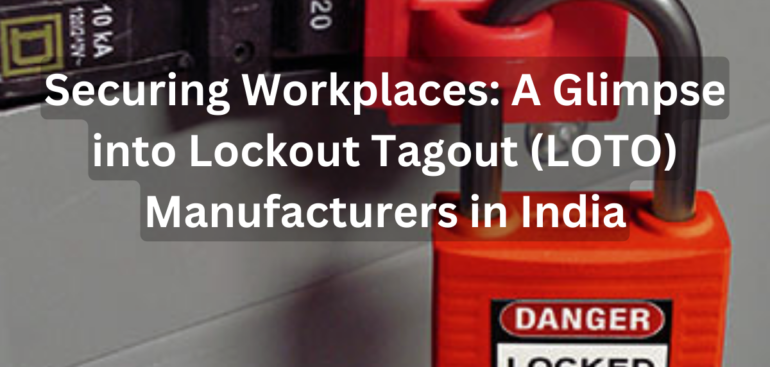Ensuring the safety of workers during maintenance and servicing of machinery is a critical aspect of any industrial operation. Lockout Tagout (LOTO) is a well-established procedure designed to prevent accidental energy release and protect employees from harm. This comprehensive guide will walk you through everything you need to know about LOTO devices, their importance, and how to implement them effectively in your workplace.
What are Lockout Tagout Devices and Their Importance?
Lockout Tagout (LOTO) devices are safety mechanisms used to isolate hazardous energy sources in machinery and equipment during maintenance or repair. They play a vital role in preventing the accidental startup of machinery or the release of stored energy, which can lead to severe injuries or fatalities.
The importance of LOTO devices lies in their ability to:
- Enhance worker safety: By ensuring machines remain de-energized, LOTO devices protect workers from unexpected hazards.
- Ensure regulatory compliance: Adhering to LOTO procedures is a legal requirement under OSHA regulations, helping organizations avoid penalties and maintain safe working conditions.
- Promote operational efficiency: Proper use of LOTO devices minimizes downtime and enhances the safety culture within an organization.
Difference Between Lockout and Tagout
Lockout and Tagout are two methods used to control hazardous energy. Here’s how they differ:
- Lockout: This method involves physically locking a device to an energy-isolating mechanism, such as a valve or switch. The lockout device, often a padlock, ensures that the machinery cannot be activated until the lock is removed by the person who applied it.
- Tagout: This method uses tags to warn personnel that the equipment is isolated and should not be operated. Unlike lockout, tagout does not provide a physical barrier to energizing the equipment but serves as a warning indicator.
While both methods aim to prevent accidental startup, lockout is generally more secure because it physically restrains the equipment from being powered on.
Lockout Tagout and Machine Guarding
Machine Guarding and LOTO are complementary safety measures that serve different purposes:
- Machine Guarding: Involves the use of physical barriers or shields to protect workers from moving parts and other operational hazards during the normal functioning of machinery.
- LOTO: Ensures that machinery is completely de-energized and incapable of accidental startup during maintenance or servicing.
Together, these safety practices provide comprehensive protection, addressing both operational safety (machine guarding) and maintenance safety (LOTO).
OSHA Lockout Tagout Standard
The Occupational Safety and Health Administration (OSHA) regulates LOTO practices under the 29 CFR 1910.147 standard. This standard specifies the requirements for controlling hazardous energy during the servicing and maintenance of machines and equipment. Key points of the standard include:
- Establishing an energy control program: Employers must develop and document procedures to isolate and control hazardous energy.
- Training employees: All employees involved in LOTO must receive proper training on their roles and responsibilities.
- Conducting periodic inspections: Regular inspections are required to ensure compliance and effectiveness of the LOTO procedures.
OSHA Lockout/Tagout Exceptions
OSHA provides certain exceptions to the LOTO requirement under specific conditions. These include:
- Cord and plug connected equipment: When equipment is unplugged and the plug remains under the exclusive control of the employee performing the service.
- Minor servicing activities: Such as minor tool changes and adjustments that are routine, repetitive, and integral to the use of the equipment, provided they do not pose significant risk.
- Hot tap operations: Involving work on pressurized pipelines where shutdown is impractical and the employer demonstrates that continuity of service is essential, and other effective safety measures are in place.
OSHA Lockout/Tagout Violations
Violations of OSHA’s LOTO standards can result in significant penalties and increased risk of accidents. Common violations include:
- Lack of a documented energy control program: Failing to have written procedures for controlling hazardous energy.
- Inadequate employee training: Not providing sufficient training for employees on LOTO practices.
- Failure to conduct periodic inspections: Neglecting to regularly inspect and verify the effectiveness of LOTO procedures.
- Improper use of LOTO devices: Using inadequate or inappropriate devices that do not effectively isolate energy sources.
Who is Involved in a Lockout Tagout?
LOTO procedures involve multiple roles, each with specific responsibilities:
- Authorized Employees: Those who perform the maintenance and apply LOTO devices. They are trained to recognize hazardous energy sources and the means to control them.
- Affected Employees: Workers who operate or use the machinery that is being serviced. They need to be aware of the LOTO procedures and understand the importance of not attempting to restart the equipment.
- Other Employees: Individuals who work in the area and may be impacted by LOTO activities. They should understand the purpose of LOTO and how it affects their safety.
Lockout Tagout Devices
LOTO devices are designed to isolate energy sources and secure machinery during maintenance. Common types include:
- Padlocks: Used to lock energy isolating devices in the off position.
- Lockout hasps: Allow multiple padlocks to secure a single energy source, ensuring that no single worker can remove the lock without others knowing.
- Valve lockouts: Devices that secure valves in the closed position, preventing the flow of liquids or gases.
- Circuit breaker lockouts: Prevent circuit breakers from being switched on, isolating electrical energy.
- Plug lockouts: Secure electrical plugs, preventing them from being connected to power sources.
What is an Energy Isolating Device?
An energy isolating device is a mechanical device that physically prevents the transmission or release of energy. Examples include:
- Manually operated disconnect switches: Cut off electrical power supply.
- Slide gates and slip blinds: Block the flow of materials in pipelines.
- Line valves: Control the flow of liquids or gases in a system.
These devices are crucial in the lockout process as they ensure hazardous energy is effectively isolated.
What is a Lockout Device?
A lockout device is a tool that locks the energy isolating device in a safe position, preventing it from being operated. Lockout devices are essential for ensuring that equipment remains de-energized until maintenance is complete and the device is safely removed by authorized personnel.
Padlocks
Padlocks are the most common type of lockout device. Each padlock should be uniquely keyed and dedicated solely for lockout purposes. The key to a padlock should be kept only by the person who applied the lock, ensuring that it can only be removed by the individual who placed it.
What is a Tagout Device?
A tagout device is a prominent warning tag attached to the energy isolating device, alerting others not to operate the equipment. Unlike lockout devices, tagout devices do not provide a physical barrier to energy release but serve as a visual warning. Tags must be securely attached and clearly visible.
Tags
Tags used in the tagout process must be durable, legible, and clearly visible. They should include:
- A warning message such as “Do Not Operate.”
- The name and contact information of the person who applied the tag.
- The date and reason for the tagout.
Tags are crucial for communication in LOTO procedures, ensuring everyone is aware of the hazards.
What is a LOTO Box?
A LOTO box, or lockout box, is a secure container used to store keys for lockout devices or other LOTO equipment. The box ensures that only authorized personnel can access the keys, providing an additional layer of security in the lockout process.
How Does a Lockout Box Work?
The lockout box works by centralizing the control of keys and lockout devices. Authorized personnel place their lockout keys inside the box, which is then secured with their personal locks. This system ensures that the equipment cannot be re-energized until all involved personnel have removed their locks from the box, confirming that it is safe to resume operation.
Colors of Lockout Locks and Tags
LOTO locks and tags often use color-coding to enhance safety and communication. Common color schemes include:
- Red: Indicates danger and is commonly used for energy isolation devices.
- Yellow: Represents caution and is often used to highlight specific hazards.
- Blue: Typically designated for maintenance or service personnel locks and tags.
What is a Lockout Tagout Procedure?
A LOTO procedure is a documented step-by-step process outlining how to isolate and secure hazardous energy sources during maintenance or servicing activities. It should include:
- Detailed descriptions of energy sources and their hazards.
- Specific steps for shutting down and isolating energy.
- Methods for securing and verifying isolation.
- Procedures for safely restarting the equipment after maintenance is completed.
7 Steps of Lockout Tagout Procedure
- Preparation: Identify the equipment to be serviced and the energy sources involved.
- Notification: Inform all affected employees about the maintenance and the need for LOTO.
- Shutdown: Power down the equipment using normal shutdown procedures.
- Isolation: Isolate the energy sources using appropriate LOTO devices.
- Lockout/Tagout Application: Apply lockout and tagout devices as required.
- Energy Dissipation: Release any stored energy by draining, bleeding, or other methods.
- Verification: Ensure that all energy sources are isolated and the equipment is de-energized before starting work.

What to Do if An Employee is Not Available to Remove the Lock?
If an employee who applied a lockout device is not available to remove it, follow your organization’s specific procedures. Generally, this involves:
- Verifying that the employee is not present.
- Attempting to contact the employee to remove the lock.
- Following a predetermined process for safely removing the lock, often involving management or safety personnel.
Establishing a Lockout Tagout Program
Establishing an effective LOTO program involves several key steps:
- Developing clear policies and procedures: Document the LOTO process and ensure it is specific to each piece of equipment.
- Training employees: Provide comprehensive training for all employees on LOTO procedures and their responsibilities.
- Providing appropriate LOTO devices: Ensure that all necessary LOTO devices are available and in good condition.
- Regularly reviewing and updating the program: Adapt the program to address new equipment or changes in the workplace.
Lockout Tagout Procedures
LOTO procedures should be specific to each piece of equipment and should include:
- A detailed description of the equipment and energy sources.
- Step-by-step instructions for shutting down and isolating energy.
- Specific lockout/tagout devices to be used.
- Verification steps to ensure all energy is isolated.
- Steps for safely re-energizing and restarting the equipment after maintenance.
Lockout Tagout Inspections
Regular inspections of LOTO procedures are crucial for maintaining safety and compliance. These inspections should verify that:
- Procedures are being followed correctly.
- LOTO devices are being used appropriately and effectively.
- Employees understand and can execute the LOTO procedures.
- Any deviations or issues are promptly addressed and corrected.
Lock Out Tag Out Training
LOTO training is essential for all employees involved in the lockout process. Training should cover:
- The purpose and use of LOTO devices.
- The specific steps in the LOTO procedure for each type of equipment.
- The roles and responsibilities of authorized, affected, and other employees.
- How to handle emergencies or unusual situations during the LOTO process.
LOTO Safety
LOTO safety is about ensuring that all workers understand and adhere to the procedures that protect them from hazardous energy. Key aspects of LOTO safety include:
- Regular training and education: Keeping employees informed and updated on LOTO practices.
- Effective communication: Clearly communicating LOTO procedures and any changes to all affected personnel.
- Commitment to following procedures: Enforcing strict adherence to LOTO protocols to prevent accidents and injuries.
Clearly Define and Communicate the Lockout Tagout Policy
A clear and well-communicated LOTO policy is essential for effective implementation. This policy should:
- Define the scope and purpose of the LOTO program.
- Outline the responsibilities of all employees involved in the LOTO process.
- Specify the procedures for locking out and tagging out equipment.
- Detail how the program will be monitored, enforced, and updated.
Create a System for Submitting and Receiving LOTO Reports
Implementing a reporting system for LOTO activities helps track and document LOTO events. This system should:
- Facilitate the submission and recording of LOTO reports by employees.
- Provide a mechanism for reporting issues, incidents, or deviations from standard procedures.
- Ensure timely communication and review of LOTO status and activities to all affected personnel.
Perform Frequent LOTO Audits
Regular audits are essential to ensure compliance and effectiveness of LOTO procedures. These audits should:
- Review the implementation and adherence to LOTO procedures.
- Check the condition and availability of LOTO devices.
- Assess the training and understanding of employees regarding LOTO practices.
- Identify areas for improvement and update procedures as necessary.
Enforce Lockout Tagout Documentation
Maintaining thorough documentation is crucial for the effectiveness and compliance of LOTO programs. Documentation should include:
- Detailed LOTO procedures for each piece of equipment.
- Records of training and certification of employees.
- Logs of LOTO activities, including dates, personnel involved, and any incidents or deviations.
- Results of periodic inspections and audits, along with corrective actions taken.
Conclusion
Implementing and maintaining effective Lockout Tagout (LOTO) procedures is critical for the safety of workers and compliance with regulatory standards. By understanding the various aspects of LOTO devices, roles, and responsibilities, and following best practices, organizations can significantly reduce the risk of accidents and injuries during maintenance activities. Stay committed to regular training, clear communication, and continuous improvement to ensure a safe and compliant workplace.
For more information and resources on Lockout Tagout devices and procedures, visit Lukko Safety and explore our range of safety solutions.



